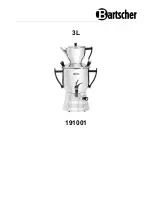
— 13 —
ELECTRIC STATIONARY KETTLES
MAINTENANCE
VENTING
The vacuum pressure gauge measuring zone
should be between 20 to 30 in.Hg (84 to
100kPa). If the vacuum pressure is not within
this range, perform the following:
1. With the kettle empty, place the power
switch to the ON position.
2. Set the temperature control to the max
heat setting. Let the kettle heat until it
cycles off.
3. Pull the pressure relieve valve D-ring to
relieve pressure for 10 seconds.
4. Turn kettle off and let cool. Check for a
correct vacuum pressure of 20 to 30 in. Hg
(84 to 100kPa). If the reading is not correct,
repeat steps 1 through 3.
60
30
150
120
90
0
Hg
vac
psi
30
60
30
150
120
90
0
Hg
vac
psi
30
Fig. 5 Rear of Kettle
FILLING THE RESERVOIR JACKET
Before adding water to the reservoir, the water
supply should be analyzed to ensure that
hardness is no greater than 2.0 grains per
gallon and the pH level is within the range of
7.0 to 8.5. Water which fails to meet these
standards should be treated, or use ionized
distilled water with sodium. Equipment failure
caused by inadequate water quality is not
covered under warranty. To fill the reservoir
jacket, perform the following:
1. Set the thermostat and power switch to
OFF position.
2. Release any pressure by the O-ring on the
pressure relief valve. Then remove the
1
/
2
"
plug on the back of the kettle.
3. Insert a funnel into the fill valve and add 3
or 4 ounces of water.
4. Replace and properly tighten the
1
/
2
" plug.
5. Turn on the kettle.
If the low water light turns on, turn off the unit
and repeat steps 3 and 4. If low water light is
off, follow the venting procedure (see
VENTING) to vent air from reservoir.
TOTAL
MODEL
DISTILLED WATER
REQUIREMENTS
K20EL / K20ELT
1.25 gallons (4.1)
K40EL / K40ELT
2.0 gallons (6.5)
K60EL / K60ELT
2.1 gallons (7.4)


































